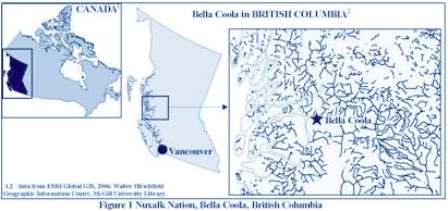NUXALK NATION, BELLA COOLA, BRITISH COLUMBIA, CANADA
Community Food System Data Tables
Introduction
 The food system and food composition studies were carried out with the Nuxalk Nation of Bella Coola, British Columbia, who live on a 25 km reserve at the mouth of the Bella Coola River on the eastern end of Burke Channel, a deep sea inlet (Figure 1).
The food system and food composition studies were carried out with the Nuxalk Nation of Bella Coola, British Columbia, who live on a 25 km reserve at the mouth of the Bella Coola River on the eastern end of Burke Channel, a deep sea inlet (Figure 1).
The purpose of the study was to assess the availability and use of traditional foods among the Nuxalk Nation. Data on use of traditional and contemporary foods were gathered by holding focus groups and conducting interviews with elders and adults in the community of 800 people.
The study team was comprised of the following:
- Sandy (Moody) Burgess, CHN
- Rose Hans, CHR
- Louise Hilland
- Emily Schooner
- Grace Hans
- Harriet Kuhnlein, Ph.D., R.D.
Notes on food groups
Users should be aware that the data presented here do not represent absolute values. The purpose of this publication is to present a true reflection of the usual composition of foods available and/or consumed among Nuxalk community members. This is a living document and nutrient information will be added and/or updated when available.
Sixty-seven different foods were identified in the food system and food composition studies. Nutrient information was obtained from the published works specified in the ‘Reference’ section. Seasonality of use, harvest information, type of procurement and other relevant information were collected through household and key informant interviews. Most of the foods eaten by the Nuxalk were harvested locally. Fish and sea food are easily accessible and therefore commonly eaten. Berries are also eaten in abundance. The foods were divided into four food groups:
Notes on food components
There are approximately 18 to 20 components in the main body of the tables, which are presented in a fixed format for each record.
The information on the analytical details for the majority of the components and conversion factors for some nutrients can be obtained from the referenced literature.
All energy values are calculated from the energy-producing food components using the following conversion factors:
- Carbohydrate 4 kcal/g
- Protein 4 kcal/g
- Fat 9 kcal/g
Vitamin A values are reported in both Vitamin A retinol equivalents (RE-ug) and in retinol activity equivalents (RAE-ug). These values are calculated and reported only for foods where retinol, beta carotene and total carotene values are available. Vitamin A RAE values are reported for compatibility with the DRI (Dietary Reference Intake) recommendations.
Where applicable, folate values are reported in Dietary Folate Equivalent (DFE) in addition to reporting synthetic folic acid, and natural folate present in foods.
References
- Kuhnlein H. V., 1989. Nutrient values in indigenous wild berries used by the Nuxalk People of Bella Coola, British Columbia. Journal of Food Composition and Analysis 2, 28–36.
- Kuhnlein H. V., 1990. Nutrient values in indigenous wild plant greens and roots used by the Nuxalk People of Bella Coola, British Columbia. Journal of Food Composition and Analysis 3, 38–46.
- Kuhnlein H. V., Yeboah F., Sedgemore M., Sedgemore S., Chan H.M., 1996. Nutritional qualities of ooligan grease: A traditional food fat of British Columbia First Nations. Journal of Food Composition and Analysis 9, 18–31.
- Nuxalk Food and Nutrition Handbook – a practical guide to family and nutrition using native foods. Produced by: The Nuxalk Food and Nutrition Program Staff. Division of Human Nutrition, School of Family and Nutritional Sciences. The University of British Columbia, and Nuxalk Health Clinic, Bella Coola, British Columbia. Reprinted, 1985.
- Canadian Nutrient File, 2005.
- Kennelly A. C. 1986. A nutrient evaluation of selected Nuxalk salmon preparations. Masters thesis. The University of British Columbia.
